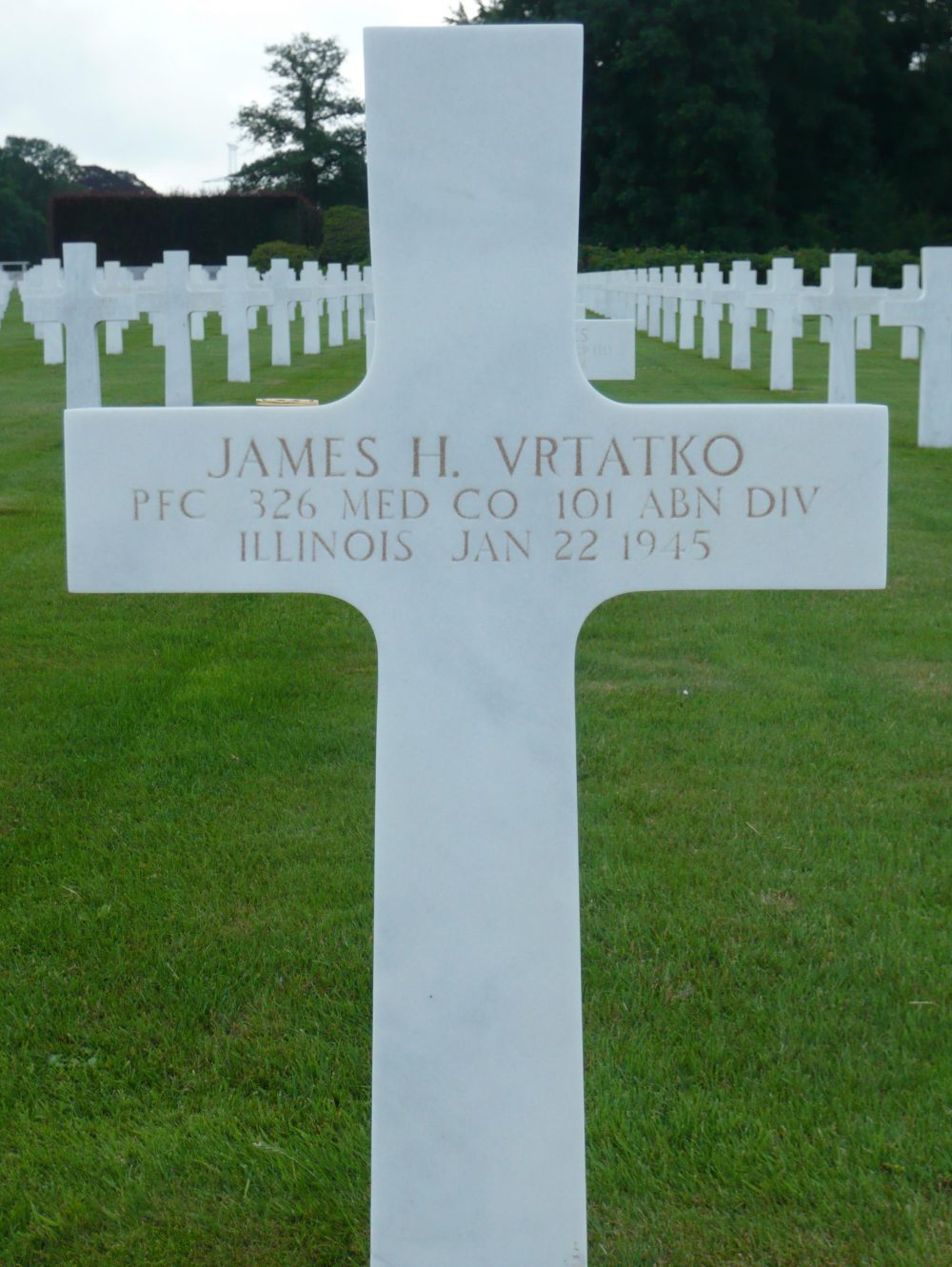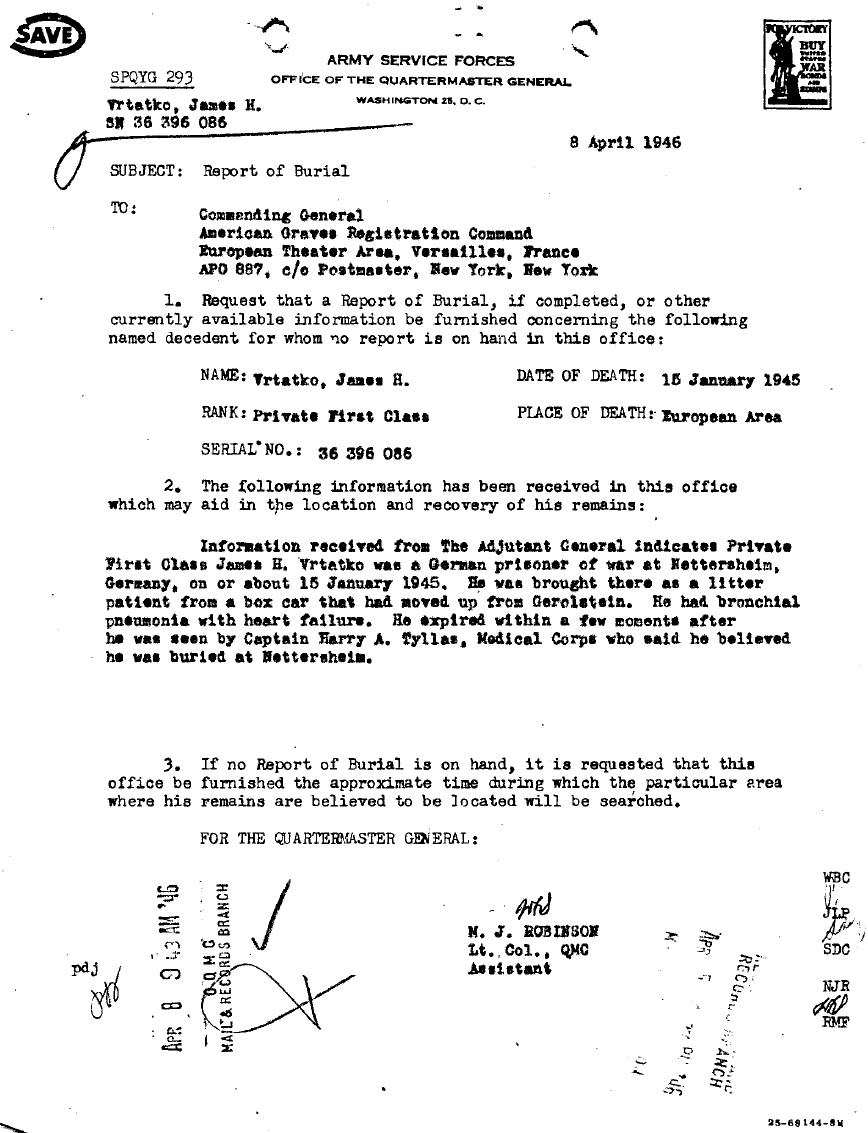Private First Class James H. Vrtatko

- Unit: 101st Airborne Division, 326th Medical Company
- Service Number: 36396086
- Date of Birth: August 1, 1908
- Entered the Military: March 20, 1942
- Date of Death: January 20, 1945
- Hometown: Chicago, Illinois
- Place of Death: Nettersheim, Germany
- Award(s): Purple Heart
- Cemetery: Plot A, Row 33, Grave 19. Ardennes American Cemetery, Neupré, Begium
Carroll County Career and Technology Center
2014-2015
Early Life
James H. Vrtatko was born in Chicago, Illinois on August 1, 1908. His parents immigrated to the United States in 1904 and owned a home in a predominantly Czechoslovakian immigrant neighborhood known as Little Village.
His mother, Barbara Vrtatko, was widowed sometime before 1930 and had two other children, Olga and Charles. Vrtatko, the oldest child in the family, did not continue his education beyond grammar school, most likely so he could work and support his family. At the age of 21, he worked as a laborer at a soda fountain and by the time he enlisted in the Army in 1942 at age 33, he was working as a stock clerk.


Military Experience
After his enlistment, he was trained as a glider combat medic in the 326th Medical Company of the 101st Airborne Division. He was with the division from their activation in August 1942.
D-Day
Vrtatko was a part of the D-Day invasion and entered Normandy on a glider to support the regiment in their elimination of German beach defenses. They secured beach exits for infantry troops followed by the capture of Carentan. After Normandy, the company moved to Cherbourg to support the operations there. Due to heavy personnel and equipment losses that the division experienced in Normandy, the 326th was shipped back to England in July where they prepared for Operation Market Garden.
Operation Market Garden
Vrtatko entered Holland on September 17, 1944 by glider and supported the 101st Airborne Division’s assault on two German Panzer Divisions in Belgium and the liberation of several Dutch towns from German control. The unit dealt with strong German counter attacks and brutal, close-quarter fighting.
The division was relieved and sent back to France on November 28, 1944, for rest. On December 17, the 326th Medical Company moved by motor convoy to Bastogne, Belgium in order to provide medical care to the 101st Airborne Division in their defense of the Ardennes Forest.
Defense of Bastogne
During the early part of the Allied defense of Bastogne, a German force mistakenly attacked the 326th Medical Division Clearing Station for a short period of 15 minutes. Once given the opportunity, the division commander surrendered the facility on December 19, 1944, and Vrtatko was initially classified missing in action until after the war when more detail was uncovered regarding his capture.
Vrtatko was taken prisoner and transferred to Gerolstein Prison Camp where conditions were abhorrent and disease was common. There he contracted bronchial pneumonia and was transferred to Nettersheim, Germany. On January 22, 1945, his heart failed, and he died.
As a medic, Vrtatko had a very unusual war experience that required an incredible amount of courage not only to be a part of major battles in the European Theater but also to face death and human suffering more intimately than many other soldiers. As a medic, rather than soldiering on to advance mission objectives, he was always running to help others who were wounded. When Vrtatko heard the cry of “medic!” he knew he was heading into the depths of human carnage left in the wake of battle.


Eulogy
Although Vrtatko was listed as missing in action on January 23, 1945, he was buried the day that he died in Nettersheim. His mother, Barbara Vrtatko, did not receive official word of his death until September 4, 1945, when his remains were recovered. His remains were then moved to a temporary cemetery in Neuville-en-Condros on August 19, 1946. His mother chose to bury her son in Belgium. On November 11, 1948, his body was transferred to the Ardennes American Cemetery, where he rests permanently. Though Vrtatko’s death came during active service to his country, his legacy and that of other fallen heroes will live on through future generations who strive to understand and learn from the soldiers’ ultimate sacrifice.


Reflection
Bibliography
101st Airborne Division After-Action Reports, 17 September-30 November 1944; Records of the Adjutant General, Record Group 407 (Box 14447), National Archives at College Park, College Park, MD.
326th Airborne Medical Company; Records of the U.S. Army Operational, Tactical, and Support Organizations (World War II and Thereafter), Record Group 338 (Box 4774); National Archives at College Park, College Park, MD.
Batens, Alian and Ben Major. “326th Airborne Medical Company Unit History.” WW2 Medical Research Centre. Accessed December 20, 2014. www.med-dept.com/unit-histories/326th-airborne-medical-company/.
Illinois. Cook County. 1930 U.S. census. Digital images. ancestry.com
“James H. Vrtatko.” American Battle Monuments Commission. Accessed February 22, 2015. www.abmc.gov/search-abmc-burials-and-memorializations/detail/WWII_9876#.VcdXuPlViko.
James H. Vrtatko, Individual Deceased Personnel File, Department of the Army.
Koskimaki, George. The Battered Bastards of Bastogne: The 101st Airborne in the Battle of the Bulge, December 19, 1944-January 17, 1945. New York: Presidio Press, 2007.
Koskimaki, George. D-Day with the Screaming Eagles. New York: Presidio Press, 2006.
Koskimaki, George. Hell’s Highway: A Chronicle of the 101st Airborne in the Holland Campaign, September-November 1944. New York: Presidio Press, 2007.
Records for James H. Vrtatko; World War II Army Enlistment Records, 1938-1946 [Electronic File], Record Group 64; National Archives at College Park, College Park, MD [retrieved from the Access to Archival Databases at aad.archives.gov/aad/series-description.jsp?s=3360&cat=WR26&bc=,sl, December 1, 2014].
Report of Captain McKee; Records of the U.S. Army Surgeon General, Record Group 112 (Box 5), National Archives at College Park, College Park, MD.
This profile was researched and created with the Understanding Sacrifice program, sponsored by the American Battle Monuments Commission.

